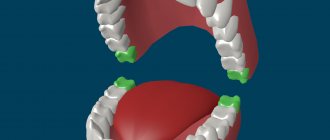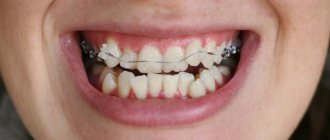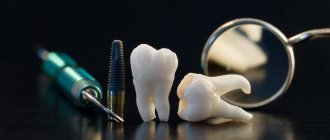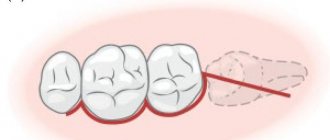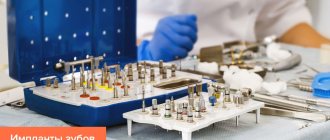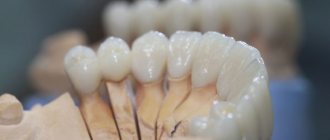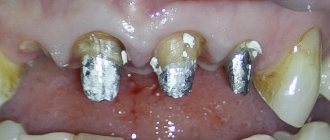Ultrasonic tooth extraction
Now you have the opportunity to change your attitude towards visiting the dental office. With the help of a piezosurgical device, it is not painful to remove a tooth for both children and adults. At the branches of the “Doctor Lyutikov Clinic” we offer you services, the quality of which is explained by the high qualifications and experience of our specialists, the use of effective medications and modern equipment, which allows us to carry out all surgical and other operations with minimal discomfort for the patient.
The advantages of a modern and highly effective technique are that:
- High-quality anesthesia is used, completely eliminating any unpleasant, let alone painful, sensations during the procedure. If desired, all manipulations are performed in a dream.
- To remove an impacted tooth, the PIEZOSURGERY ultrasonic system is used rather than forceps. Thanks to this, it is possible to avoid injury. If necessary, using an ultrasonic attachment, the tooth is separated from the bone tissue or divided into parts. This eliminates the burn of bone tissue that occurs when sawing bone with a drill, and does not damage adjacent tissues, nerves and blood vessels.
- After extraction, the tooth socket is sterilized with a laser to prevent the formation of bacteria and infection.
- A synthetic bone preparation is injected into the socket of an impacted tooth to quickly restore damaged tissue. Clinic specialists use synthetic bone based on tricalcium phosphate. This material, when compared with artificial bone of animal origin (from pigs or cattle), does not contain proteins that often cause rejection and the development of allergic reactions.
- An important point is that the method of tooth extraction at the Bionic Dentis clinic includes the use of active PRF regeneration proteins obtained from the patient’s blood. To do this, blood is first taken from a vein, which is processed using modern equipment installed in the clinic. You can get a blood regeneration protein drug that ensures 99% of synthetic bone engraftment in just 15 minutes.
- Sutures are placed at the removal site to protect the socket from food and external irritants. This approach promotes rapid tissue healing, preventing the formation of swelling and the development of pain.
This technique has no contraindications. It has been used widely and for a long time in the USA and European countries. During this time, she has proven herself only from the best side.
| ULTRASONIC REMOVAL OF IMPACTED TOOTH | USING NON-ANIMAL SYNTHETIC BONE | APPLICATION OF ACTIVE PRF REGENERATION PROTEINS |
| EUROPEAN PROTOCOL FOR STERILITY OF INSTRUMENTS IN THE CLINIC | HIGH QUALIFICATION AND EXTENSIVE EXPERIENCE OF DENTAL SURGEON | CAREFUL DIAGNOSIS AND REMOVAL PLANNING ON YOUR OWN ORTHOPANTOMOGRAPHER |
In Moscow dental clinics, the method of removing an impacted tooth with bone grafting has not yet become widespread.
Its implementation requires expensive equipment and materials. Namely:
- dental laser;
- PIEZOSURGERY device;
- synthetic bone preparations and PRF.
In 2006, dental surgeons from the Bionic Dentis clinic (Moscow) successfully completed an internship in Germany in modern surgical techniques for removing impacted teeth. For further work using the new method, the clinic purchased the necessary high-tech equipment.
During this time, specialists provided assistance to more than 1000 patients with the problem of impacted teeth. A new technique for removing an impacted tooth with bone grafting at the Bionic Dentis clinic allows patients to recover quickly, go back to work the next day and lead a normal lifestyle. In addition, many years of experience show that the rehabilitation period is reduced by 3 times when compared with the conventional method.
The development of modern dentistry in Western countries is directed towards microinvasiveness and atraumaticity. The use of high-quality artificial bone preparations, lasers and high professional training of specialists allows us to completely eliminate unpleasant sensations and speed up the recovery process, regardless of the type of intervention.
What is the principle of ultrasonic tooth extraction
Today, ultrasonic tooth extraction is the most advanced method of dental surgery. An ultrasonic pointer is used to excise tissue without damaging the gums, nerves, or blood vessels. The cuts are extremely precise and thin. There is no direct contact between the device and the tissue, thereby eliminating the risk of infection. The hardest tissues are amenable to ultrasonic waves, without affecting or injuring adjacent soft tissues.
If burns are acceptable when using a drill, then burns are excluded when using ultrasound. And this is not the only advantage of ultrasound over a drill. Ultrasound makes it possible to perform operations in places that are difficult to reach with a drill; complex teeth and even unerupted teeth can be removed without injury.
Removal technology
Stages of the procedure using the example of an incompletely erupted wisdom tooth:
- Diagnosis of contraindications.
- The patient is given local anesthesia.
- An ultrasonic “scalpel” is used to peel off the gum tissue to free the surgical field.
- The tooth is carefully defragmented using ultrasound (without pain, pressure or touching the equipment to the tissue).
- The tooth elements are easily removed from the socket along with the roots.
- The mucous membrane is returned to its place, and stitches are applied if necessary.
What are the main advantages of the piezosurgical device?
- The speed of the operation is 15–20% faster than the traditional method. This is convenient especially if it is necessary to remove several teeth at once;
- It is not only simple, but also not painful to remove a tooth. This method can become an alternative to dental treatment under anesthesia, limiting oneself to local anesthetic during even the most complex operations;
- Allows removal of dystopic, impacted teeth;
- There is practically no blood during the operation, which can be explained by the rapidity of the intervention;
- Avoid heating and causing burns to soft tissues. Please note: heating is especially dangerous for the pulp - it can become inflamed.
- This technology allows operations to be performed even on patients who suffer from vascular diseases;
- This is the only option for tooth extraction for a patient with poor blood clotting;
- Antiseptic effect of ultrasound, which is good when performing operations on people allergic to antiseptic drugs;
- The risk of postoperative complications is extremely low;
- Non-contact influence of the device.
If we talk about the disadvantages of this removal method, then there is probably only one – cost. The price of ultrasonic tooth extraction is several times higher than conventional methods, although it cannot be called inaccessible. And the antiseptic effect of the ultrasonic pointer eliminates the need to prescribe antibiotics. And now parents don’t have to lie that it doesn’t hurt at all to remove a tooth - with ultrasound this is true.
Contraindications
Despite the presence of a large number of positive qualities, this procedure has contraindications. Dentists do not recommend this method in the presence of the following disorders and conditions:
- Should not be used if you have bronchial asthma or obstructive pulmonary disorders (emphysema, asthmatic bronchitis).
Important! If this procedure is used for these violations, serious consequences may arise - the formation of an aerosol cloud near the activated nozzle can cause bronchospasm; - If there are severe cardiac and vascular disorders;
- In cases where there are various mental disorders, feverish abnormalities;
- It is contraindicated to use ultrasound surgery in areas with demineralization of the enamel coating;
- Should not be used during periods of changing deciduous dentition;
- In the presence of diseases that are transmitted by airborne droplets - herpes, tuberculosis;
- Not recommended for pathologies of hematogenous transmission - viral hepatitis, HIV infection.
Indications for ultrasonic tooth extraction
Anyone can remove a tooth using a piezosurgical device, but dentists have not yet completely switched to this method - standard removal methods are still safe and effective. Indications for ultrasonic removal are:
- Incorrect position of the tooth in the dentition;
- The presence of an obstacle in the form of hard or soft tissue to tooth growth;
- The need for implantation immediately after removal;
- The presence of blood diseases in the patient;
- The need for tooth extraction in a pregnant woman.
Removing impacted teeth using a piezo knife
Modern technology helps to quickly get rid of dystopic teeth once and for all. These teeth are those that are incorrectly positioned or simply begin to shift due to some factors. One such tooth is already a reason to worry. Over time, it can cause a shift in the ranks of everyone else and then you will have big problems. Along with a violation of the location of the dentition, malocclusion very often appears. There are such severe cases when the teeth are generally placed perpendicular to the direction of growth. If you are faced with such a problem, then you should turn to piezo surgery.
Piezosurgery
Dentistry can rightfully be called one of the fastest growing areas of medicine. Specialists are constantly improving methods of treating teeth and gums. Among their newest developments is piezosurgery, which means performing surgical operations using an ultrasonic knife. This is a kind of analogue of a drill with the difference that it carefully and accurately cuts both hard and soft tissues without burning or overheating, without injuring blood vessels and nerves. The device operates through ultrasonic waves, which reach the most inaccessible places, which are very difficult to reach with a drill or a regular surgical knife. This is especially important when extracting unerupted teeth.
TOOTH EXTRACTION OF ANY COMPLEXITY FOR RUB 3,000.
The use of piezosurgery reduces the level of tissue trauma and promotes rapid rehabilitation of the socket. Save 1500r. >>
+7 or write to us
Piezosurgery: indications
- bone grafting (selection and transplantation of bone tissue to increase the volume of the jaw bone) before dental implantation,
- removal of teeth (especially wisdom teeth hidden in the gums),
- Maxillofacial Surgery,
- removal of cysts and granulomas.
Piezosurgery: contraindications
The main contraindications are diseases for which the use of ultrasound is prohibited - surgery is not recommended for cardiovascular and oncological diseases, diabetes mellitus, reduced immunity, disorders of the central nervous system, as well as if a pacemaker is installed.
Piezosurgery technology
A specially designed high-precision ultrasound system is used to perform surgical operations.
The ultrasonic device has several attachments included to solve various problems during the operation: for cutting gums, for cleaning the tooth cavity from carious formations, for working with hard bone tissue, and so on. The device allows you to irrigate the incision site with a special cooling solution, and the surgeon cuts hard tissue as quickly as possible thanks to ultrasonic vibrations, simply by pointing the tip at the incision area. The operation can be called virtually bloodless due to the speed and minimal surgical intervention.
Ultrasound has a disinfecting property, due to which a minimum of chemical compounds are used for disinfection, and tissues damaged after surgery are restored in a short time.
Piezosurgery: benefits
- almost absolute accuracy of cuts: ultrasound reduces operation time by 15-20% compared to conservative methods, while the incision and tissue damage are tens of times less than when using a drill or a conventional scalpel,
- the ability to operate on the most inaccessible places,
- painless and bloodless procedure,
- safety: ultrasound has a minimal effect on tissue, which minimizes complications such as injury to blood vessels and nerves, bleeding, pain and swelling,
- the disinfecting properties of ultrasound lead to a much faster recovery of the patient after the procedure,
- one of the main advantages of piezosurgery is the almost completely predictable favorable outcome of the operation both during treatment and during dental implantation,
- Ultrasound, unlike boron, does not come into contact with tissue at all. Non-contact surgery is one of the most promising areas of dentistry today.
Piezosurgery is not used today as often as we would like. This is due to the fact that its implementation requires not only the appropriate skill of a dental surgeon, but also the availability of equipment. This method of surgical operation is successfully used by dentists in the USA and Western Europe and is gradually spreading to clinics in our country.
Features of treatment with the piezo apparatus
The piezosurgical device reveals the widest possibilities, including:
- Removal of impacted, dystopic teeth.
- Reducing the time of operations.
- No bleeding.
- No overheating of tissues.
- Possibility of performing operations on patients with diseases of the cardiovascular system. To remove a tooth from a patient with a bleeding disorder can only be done using ultrasound.
- No contact with the device during treatment.
- Minimal risk of complications.
- Minimum rehabilitation period.

